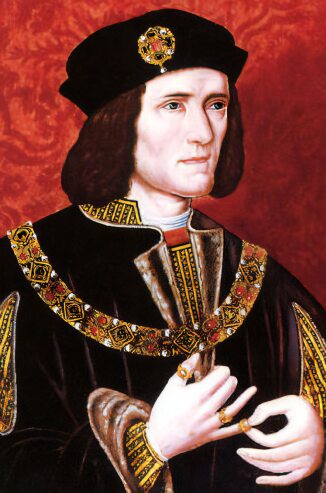One of the first things noticed when the bones were found was a very curved spine. This is scoiliosis, which fits the 'hunched' historical description. Scoiliosis is a condition that gives the spine an S or C shape bending to the left of right (not actually a hunched forward spine which is a different condition called kyphosis). With up to 70% of adults over 65 having some degree of scoilisis, and a significant number younger people being affected, there are most likely a huge number of people who can sympathise with Richard. And for 8 out of 10 cases of scoliosis the cause is unknown.
The next thing they noticed was that our Richard had wounds to the skull. His bones were put in a CT scan to study the trauma in detail. The images produced by a CT scan (called tomograms) are more detailed than standard X-rays. For living subjects, a CT scan can produce images of structures inside the body including the internal organs, blood vessels, bones and tumours. From this bone CT scan and a very clever trauma team, the wounds were matched to historical accounts and weapons of the time to describe his, quite frankly horrific death.
Carbon dating of the skeleton was carried out to give the time frame of 1450-1540 A.D. (with 95% probability), which matched to the time of Richards life. Carbon dating measures the amount of radioactive carbon-14 in an object, which decays over time. From knowing how much carbon-14 was originally in an object (or person) and measuring the amount of carbon-14 present at current day, the amount that has been lost can be used to produce a relatively reliable time frame.

Facial reconstruction was also carried out, which personally made me think how bloody amazing science and technology are. This technology is otherwise used for criminal investigations. From a skull, a whole facial structure could be made, and some very talented individuals were then able to make a life size model of his head. Clever eh.
Genetics of a living decendent, a nephew in the 17th generation who happened to be a cabinet maker from north London, were matched to DNA of the remains to give the final confirmation. Saying that, New Scientist pointed out the importance of scrutiny and the DNA analysis will come under peer review now it has been released to the press.
If you haven't watched the documentary, then do. Go to 4od now and watch a really good programme with a slightly nutty Richard III enthusiast who keeps crying. The programme questions the character of the King, whether he killed his nephews to reach the throne or not, whether he was the evil hunched figure described by Shakespeare, or a nice bloke unfairly portrayed by the Tudors. Whatever his character, this King, unlike any other, has been the King of a country... and a car park.
References
http://www.newscientist.com/mobile/article/mg21729033.500-open-richard-iii-dna-evidence-for-peer-review.html
http://www.nhs.uk/Conditions/Scoliosis/Pages/Causes.aspx
http://www.bbc.co.uk/history/ancient/archaeology/carbon_dating_01.shtml
http://www.nhs.uk/conditions/ct-scan/pages/introduction.aspx
*Note from the blogger: I just wanted to say thanks for reading, it has been a while since I posted anything as I'm now a busy lady balancing studying and working, but if you like my blog then please let me know by liking my facebook page www.facebook.com/HumanInterests and if you have any ideas for posts please get in touch! Cheers :)


No comments:
Post a Comment